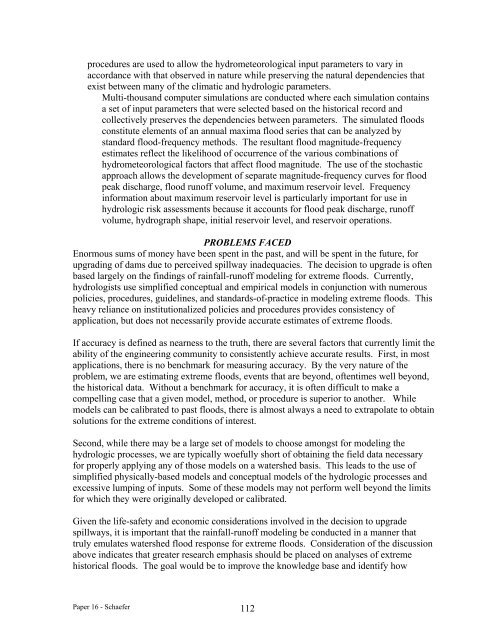Hydrologic Issues for Dams - Association of State Dam Safety Officials
Hydrologic Issues for Dams - Association of State Dam Safety Officials
Hydrologic Issues for Dams - Association of State Dam Safety Officials
Create successful ePaper yourself
Turn your PDF publications into a flip-book with our unique Google optimized e-Paper software.
pro cedures are used to allow the hydrometeorological input parameters to vary inaccordance with that observed in nature while preserving the natural dependencies thatexist between many <strong>of</strong> the climatic and hydrologic parameters.Multi-thousand computer simulations are conducted where each simulation containsa set <strong>of</strong> input parameters that were selected based on the historical record andcollectively preserves the dependencies between parameters. The simulated floodsconstitute elements <strong>of</strong> an annual maxima flood series that can be analyzed bystandard flood-frequency methods. The resultant flood magnitude-frequencyestimates reflect the likelihood <strong>of</strong> occurrence <strong>of</strong> the various combinations <strong>of</strong>hydrometeorological factors that affect flood magnitude. The use <strong>of</strong> the stochasticapproach allows the development <strong>of</strong> separate magnitude-frequency curves <strong>for</strong> floodpeak discharge, flood run<strong>of</strong>f volume, and maximum reservoir level. Frequencyin<strong>for</strong>mation about maximum reservoir level is particularly important <strong>for</strong> use inhydrologic risk assessments because it accounts <strong>for</strong> flood peak discharge, run<strong>of</strong>fvolume, hydrograph shape, initial reservoir level, and reservoir operations.PROBLEMS FACEDEnormous sums <strong>of</strong> money have been spent in the past, and will be spent in the future, <strong>for</strong>upgrading <strong>of</strong> dams due to perceived spillway inadequacies. The decision to upgrade is <strong>of</strong>tenbased largely on the findings <strong>of</strong> rainfall-run<strong>of</strong>f modeling <strong>for</strong> extreme floods. Currently,hydrologists use simplified conceptual and empirical models in conjunction with numerouspolicies, procedures, guidelines, and standards-<strong>of</strong>-practice in modeling extreme floods. Thisheavy reliance on institutionalized policies and procedures provides consistency <strong>of</strong>application, but does not necessarily provide accurate estimates <strong>of</strong> extreme floods.If accuracy is defined as nearness to the truth, there are several factors that currently limit theability <strong>of</strong> the engineering community to consistently achieve accurate results. First, in mostapplications, there is no benchmark <strong>for</strong> measuring accuracy. By the very nature <strong>of</strong> theproblem, we are estimating extreme floods, events that are beyond, <strong>of</strong>tentimes well beyond,the historical data. Without a benchmark <strong>for</strong> accuracy, it is <strong>of</strong>ten difficult to make acompelling case that a given model, method, or procedure is superior to another. Whilemodels can be calibrated to past floods, there is almost always a need to extrapolate to obtainsolutions <strong>for</strong> the extreme conditions <strong>of</strong> interest.Second, while there may be a large set <strong>of</strong> models to choose amongst <strong>for</strong> modeling thehydrologic processes, we are typically woefully short <strong>of</strong> obtaining the field data necessary<strong>for</strong> properly applying any <strong>of</strong> those models on a watershed basis. This leads to the use <strong>of</strong>simplified physically-based models and conceptual models <strong>of</strong> the hydrologic processes andexcessive lumping <strong>of</strong> inputs. Some <strong>of</strong> these models may not per<strong>for</strong>m well beyond the limits<strong>for</strong> which they were originally developed or calibrated.Given the life-safety and economic considerations involved in the decision to upgradespillways, it is important that the rainfall-run<strong>of</strong>f modeling be conducted in a manner thattruly emulates watershed flood response <strong>for</strong> extreme floods. Consideration <strong>of</strong> the discussionabove indicates that greater research emphasis should be placed on analyses <strong>of</strong> extremehistorical floods. The goal would be to improve the knowledge base and identify howPaper 16 - Schaefer 112

















